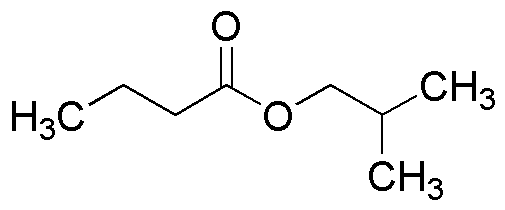Isobutyl butyrate is widely utilized in research focused on:
- Flavor and Fragrance Industry: This compound is commonly used as a flavoring agent in food products and as a fragrance component in perfumes and cosmetics, providing a fruity aroma that enhances sensory appeal.
- Solvent Applications: It serves as an effective solvent in various industrial processes, particularly in coatings and adhesives, where it helps dissolve other substances and improves product consistency.
- Pharmaceutical Formulations: In the pharmaceutical industry, isobutyl butyrate is used as an excipient, aiding in the formulation of drugs by enhancing solubility and bioavailability.
- Polymer Production: This chemical acts as a plasticizer in the production of polymers, improving flexibility and durability in materials such as plastics and rubber.
- Research and Development: It is often employed in laboratories for various chemical syntheses and reactions, providing a versatile medium for researchers exploring new compounds and materials.
General Information
Properties
Safety and Regulations
Applications
Isobutyl butyrate is widely utilized in research focused on:
- Flavor and Fragrance Industry: This compound is commonly used as a flavoring agent in food products and as a fragrance component in perfumes and cosmetics, providing a fruity aroma that enhances sensory appeal.
- Solvent Applications: It serves as an effective solvent in various industrial processes, particularly in coatings and adhesives, where it helps dissolve other substances and improves product consistency.
- Pharmaceutical Formulations: In the pharmaceutical industry, isobutyl butyrate is used as an excipient, aiding in the formulation of drugs by enhancing solubility and bioavailability.
- Polymer Production: This chemical acts as a plasticizer in the production of polymers, improving flexibility and durability in materials such as plastics and rubber.
- Research and Development: It is often employed in laboratories for various chemical syntheses and reactions, providing a versatile medium for researchers exploring new compounds and materials.
Documents
Safety Data Sheets (SDS)
The SDS provides comprehensive safety information on handling, storage, and disposal of the product.
Product Specification (PS)
The PS provides a comprehensive breakdown of the product’s properties, including chemical composition, physical state, purity, and storage requirements. It also details acceptable quality ranges and the product's intended applications.
Certificates of Analysis (COA)
Search for Certificates of Analysis (COA) by entering the products Lot Number. Lot and Batch Numbers can be found on a product’s label following the words ‘Lot’ or ‘Batch’.
*Catalog Number
*Lot Number
Certificates Of Origin (COO)
This COO confirms the country where the product was manufactured, and also details the materials and components used in it and whether it is derived from natural, synthetic, or other specific sources. This certificate may be required for customs, trade, and regulatory compliance.
*Catalog Number
*Lot Number
Safety Data Sheets (SDS)
The SDS provides comprehensive safety information on handling, storage, and disposal of the product.
DownloadProduct Specification (PS)
The PS provides a comprehensive breakdown of the product’s properties, including chemical composition, physical state, purity, and storage requirements. It also details acceptable quality ranges and the product's intended applications.
DownloadCertificates of Analysis (COA)
Search for Certificates of Analysis (COA) by entering the products Lot Number. Lot and Batch Numbers can be found on a product’s label following the words ‘Lot’ or ‘Batch’.
*Catalog Number
*Lot Number
Certificates Of Origin (COO)
This COO confirms the country where the product was manufactured, and also details the materials and components used in it and whether it is derived from natural, synthetic, or other specific sources. This certificate may be required for customs, trade, and regulatory compliance.

